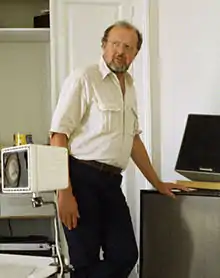Max Neuhaus
Max Neuhaus (August 9, 1939 – February 3, 2009) was an American classical musician and artist who was a noted interpreter of the experimental percussion music in the 1960s.[1] He later created numerous permanent sound installations as "sound sculptures" of contemporary art.
Max Neuhaus | |
|---|---|
 | |
| Background information | |
| Born | August 9, 1939 |
| Died | February 3, 2009 (aged 69) |
| Genres | Avant-garde, experimental |
| Occupation(s) | Public art, sound art, sound installation |
| Years active | 1957–2009 |
| Website | https://www.max-neuhaus.estate |
Career
Neuhaus was known for his interpretations of experimental percussion music. He gave performances of pieces by composers such as John Cage, Karlheinz Stockhausen and Pierre Boulez in numerous music halls, including a 1964 performance in Carnegie Hall. In 1968, he pursued a career as a contemporary artist by developing sound installations of electronic sounds which would emanate from a source within a particular space or location. One piece called Times Square was built in 1977 beneath a grate on a traffic island in Manhattan where pedestrians would be "enveloped by a deeply resonant and mildly undulating drone, its tone suggestive of low-pitched chimes or church bells."[1] Other sculptural works included penny whistles heard underwater in swimming pools, electronic sounds within an arboretum and the modified sounds of listeners whistling tunes over public radio. Permanent works by Neuhaus are found in locations in Houston; Stommeln, Germany; Promenade du Pin, Geneva, Switzerland; and the Dia:Beacon museum in Beacon, New York.[1]
Personal life
Neuhaus was born August 9, 1939 in Beaumont, Texas and attended high school in Houston. He earned bachelor's and master's degrees in music composition from the Manhattan School of Music. Neuhaus was married with two daughters. He died of cancer in his then hometown of Maratea, Italy on February 3, 2009.[1]
References
- Weber, Bruce (February 9, 2009). "Max Neuhaus, Who Made Aural Artwork, Dies at 69". New York Times. p. A20. Retrieved November 3, 2015.
Further reading
- Ammann, Jean-Christophe (1983). "Notes on Max Neuhaus". Max Neuhaus: Sound Installation [German, English]. Kunsthalle Basel.
- Cooke, Lynne, Karen Kelly and Barbara Schröder, eds. (2009). Max Neuhaus: Times Square, Time Piece Beacon. Dia Art Foundation.
- Danto, Arthur (March 4, 1991). "Max Neuhaus: Sound Works". The Nation.
- Eppley, Charles (May 2017). Soundsites: Max Neuhaus, Site-Specificity, and the Materiality of Sound as Place. Dissertation. Stony Brook University.
- Eppley, Charles (December 2017). "Times Square: Strategies and Contingencies of Preserving Sonic Art," Leonardo Music Journal.
- Goldstein, Malcolm (June 1964). "Neuhaus Realizations". The Village Voice.
- Johnson, Tom (October 6, 1976). "Creating the Context: Max Neuhaus". The Village Voice.
- La Barbara, Joan (October 1977). "Max Neuhaus: new sounds in natural settings". Musical America.
- Loock, Ulrich (2005). "Times Square, Max Neuhaus's Sound Work in New York City". Open: Cahier on Art in the Public Domain.
- Loock, Ulrich (2007). "The Time Piece for the Stommeln Synagogue". Max Neuhaus Time Piece Stomme. Pulheim: Der Bürgermeister.
- Murph, Megan (2013), Max Neuhaus and the Musical Avant-Garde. Thesis. Louisiana State University.
- Murph, Megan (2018). Max Neuhaus, R. Murray Schafer, and the Challenges of Noise. Dissertation. University of Kentucky.
- Rockwell, John (1983). All American Music: Composition in the Late Twentieth Century. New York: Alfred A. Knopf, Inc. pp. 145–53. ISBN 0-394-51163-8.
- Safran, Yehuda (December 2004). "Shaping Sound". Domus 876.
- Salzman, Eric (November 1968). "Max Neuhaus' Electronics and Percussion". HiFi Stereo Review.
- Strongin, Theodore (June 3, 1964). "Concert Is Given By Percussionist". New York Times.
- Tazzi, Pier Luigi (November 1997). "Constructed Sound: Max Neuhaus". Carte d'Arte Internazionale (Messina).
- Tomkins, Calvin (October 24, 1988). "HEAR". The New Yorker.
External links
https://www.max-neuhaus.estate
- Max Neuhaus papers, 1950s-1980 (Columbia University, Archival Collections: Rare Book and Manuscript Library)
- Max Neuhaus Website (Archive from June 26, 2018; accessed February 1, 2019)
- Auracle
- Dia Art Foundation: Times Square
- Dia Art Foundation: Time Piece Beacon
- Kunsthaus Graz: Time Piece Graz
- Max Neuhaus Papers at the Rare Book and Manuscript Library, Columbia University, New York, NY